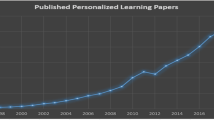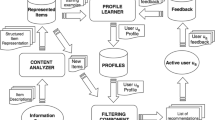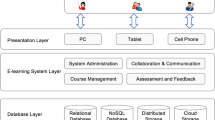Abstract
Architectural supports, e.g., user context processing and learning content management are essential for facilitating the development and proliferation of context-aware e-learning services. In this paper, we propose a context-aware e-learning infrastructure called Semantic Learning Space. It leverages the Semantic Web technologies to support semantic knowledge representation, systematic context management, interoperable content integration, expressive knowledge query, and adaptive content recommendation. The functionality encapsulated in the infrastructure handles the common, time-consuming and low-level details in learning context processing and content management. The architectural design and enabling technologies are described in detail. Finally, the prototype implementation and preliminary experimental results are presented.






Similar content being viewed by others
References
ACM taxonomy, http://www.acm.org/class/1998/
Carroll JJ, Reynolds D, Dickinson I, Seaborne A, Dollin C, Wilkinson K (2004) Jena: Implementing the Semantic Web recommendations. Proc. of 13th Intl Conf. on World Wide Web (WWW 2004), New York, pp 74–83
Dey AK, Abowd GD (2001) A conceptual framework and a toolkit for supporting the rapid prototyping of context-aware applications. Human-Computer Interaction Journal 16(2–4):97–166
Fischer G (2001) User modeling in human-computer interaction. User Model User-Adap Inter 11(1/2):65–86
Gruber T (1993) A translation approach to portable ontology specification. Knowledge Acquisition 5(2):199–220
Huang W, Webster D, Wood D, Ishaya T (2006) An intelligent semantic e-learning framework using context-aware Semantic Web technologies. Br J Educ Technol 37(3):351–373
Jovanovic J, Devedzic V, Gasevic D, Hatala M, Eap T, Richards G, Brooks C (2007) Using Semantic Web Technologies for the analysis of learning content. IEEE Internet Comput 11(5):45–53
McGuinness DL, Harmelen F, OWL web ontology language overview. W3C Recommendation
Miller L, Seaborne A, Reggiori A, Three implementations of SquishQL, a SimpleRDF query language. Proc. Of 1st Intl. Semantic Web Conf. (ISWC 2002), pp 423–435
Nabeth T, Razmerita L, Angehrn A, Roda C (December 2005) InCA: a cognitive multi-agents architecture for designing intelligent & adaptive learning systems. Computer Science and Information Systems 2(2):99–114
Ogata H, Yano Y (2004) Context-aware support for computer-supported ubiquitous learning. The 2nd IEEE International Workshop on Wireless and Mobile Technologies in Education (WMTE 2004), Taoyuan, pp 27–34
OKI project, http://www.okiproject.org/
Paraskakis I (2005) Ambient learning: A new paradigm for e-learning. The 3rd International Conference on Multimedia and Information & Communication Technologies in Education (m-ICTE2005), Spain, pp 26–30
Sakai project, http://sakaiproject.org/
Schmidt A, Winterhalter C (2004) User context aware delivery of e-learning material: approach and architecture. J Univers Comput Sci 10(1):28–36
Simon B, Mikls Z, Nejdl W, Sintek M, Salvachua J (2003) Smart space for learning: A mediation infrastructure for learning services. The 12th International Conference on World Wide Web, Budapest, pp 616–620
Stojanovic L, Staab S, Studer R (2001) eLearning based on the Semantic Web. In: Proceedings of the World Conference on the WWW and Internet (WebNet 2001), Orlando
Tane J, Schmitz C, Stumme G (2004) Semantic resource management for the web: An e-learning application. The 13th International World Wide Web Conference on Alternate Track Papers and Posters, New York, pp 1–10
Uhlmann S, Lugmayr A, Personalization algorithms for portable personality. The 12th International Conference on Entertainment and Media in the Ubiquitous Era (MindTrek 2008), Tampere, October 7–9, pp 117–121
Wolf C (2003) iWeaver: Towards ‘learning style’-based e-Learning in computer science education. The 5th Australian Computing Education Conference (ACE 2003), Adelaide, pp 273–279
Yang SJ (2006) Context aware ubiquitous learning environments for peer-to-peer collaborative learning. Educ Technol Soc 9(1):188–201
Yu Z, Lin N, Nakamura Y, Kajita S, Mase K (2007) Fuzzy recommendation towards QoS-aware pervasive learning. The IEEE 21st International Conference on Advanced Information Networking and Applications (AINA 2007), Niagara Falls, pp 846–851
Yu Z, Nakamura Y, Jang S, Kajita S, Mase K (2007) Ontology-based semantic recommendation for context-aware e-learning. The 4th International Conference on Ubiquitous Intelligence and Computing (UIC 2007), Hong Kong, pp 898–907
Yu Z, Nakamura Y, Zhang D, Kajita S, Mase K (2008) Content provisioning for ubiquitous learning. IEEE Pervasive Comput 7(4):62–70
Yu Z, Zhou X, Hao Y, Gu J (2006) TV program recommendation for multiple viewers based on user profile merging. User Model User-Adap Inter 16(1):63–82
Yu Z, Zhou X, Zhang D, Chin CY, Wang X, Men J (2006) Supporting context-aware media recommendations for smart phones. IEEE Pervasive Comput 5(3):68–75
Acknowledgment
This work was partially supported by the High-Tech Program of China (863) (No. 2009AA011903), the National Natural Science Foundation of China (No. 60903125, 60803044), Specialized Research Fund for the Doctoral Program of Higher Education (No. 20070699014), France ICT-Asia project “I-CROSS: Impromptu, Context-aware and Trustworthy Service Provision in Heterogeneous and Unfamiliar Spaces”, and the Science Foundation Ireland under grant No. SFI/08/CE/I1380 (Lion-2).
Author information
Authors and Affiliations
Corresponding author
Rights and permissions
About this article
Cite this article
Yu, Z., Zhou, X. & Shu, L. Towards a semantic infrastructure for context-aware e-learning. Multimed Tools Appl 47, 71–86 (2010). https://doi.org/10.1007/s11042-009-0407-4
Published:
Issue Date:
DOI: https://doi.org/10.1007/s11042-009-0407-4




